An attic provides you with additional space for storing toys, home decor, old clothes, and what-have-you. But the attic can also be a prime spot for working, entertaining, or living if you’re willing to do some renovations. Depending on your attic’s size and layout, you can transform it into a comfortable living space. Whether you plan to rent it out, create a new guest room, or use it for supplemental income, read on to learn more about performing an attic conversion.
Ideas for attic conversion
No two attics are alike, but most offer extra square footage that can be used for a wide variety of activities. Many homeowners choose to transform their attic into a rumpus room for the kids or the home’s entertainment hub, but those are just two of many ways you can use the extra space. Here are a few ideas to get your wheels turning about the possibilities for your attic space.
Create a guest room
If you don’t have a spare bedroom, your attic can be the perfect place for overnight guests. The most crucial factor to consider for this attic renovation is the attic’s height and weight, or load, and it can handle. Start by going into your attic and walking around. If you can do that without your head hitting the ceiling, it should make an excellent guest room. When you do this type of renovation, you’re adding additional weight or load to the upper portion of your home. It’s recommended that you consult with a structural engineer to determine just how much extra support this new guest room will require. You may need to add more plywood to attic flooring or install beams to help support the home’s structure. You’ll also want to revisit your attic access and install new, more durable stairs so that it’s safe for guests to come and go.
Apartment for rent
Another way to get more out of your attic is to turn it into a rented apartment. Things like ceiling height and load will also need to be considered for this type of attic conversion. But before you start decorating and buying appliances for your new attic apartment, you’ll need to determine what laws your local jurisdiction has in place for renting out your home. Some areas may require a certain amount of square footage or other specifics before it can be legally rented to tenants. Ensure that your new attic has everything a tenant needs to live comfortably, including proper attic HVAC heating and cooling, since attics tend to be hotter or colder than the rest of the home. You’ll also need to have plumbing and electrical installed for the bathroom and kitchen.
Rent to a small business
Renting your attic to a small business is a smart way to earn extra income, but it often comes with a few caveats. Make sure that you’re able to legally convert your attic into a workable space that can be used by those conducting business. Even if your attic is small, it can be a wonderful studio to rent to artists or those who need a quiet workspace where they can focus alone. Just make sure that you have all of the proper rental permits in place and schedule any necessary inspections before you sign a lease.
Storage and cleaning tips
No matter what type of attic design or renovation you choose, it’s essential to keep it clean and maximize your available storage space. Here are a few helpful cleaning and attic storage tips to ensure that your attic gives you the best use of space:
- Remove everything from your attic, and sweep the floors to see how much space you have to work with.
- Look for signs of leaking or other damage, and if you find evidence, call a building contractor to take a look. Even if you don’t see any damage, an attic inspection isn’t a bad idea at this point.
- Investigate for evidence of wildlife or pests, including hives, nests, and droppings. Contact a pest control company to investigate and safely eradicate pests or relocate critters like snakes, bats, or raccoons.
- Go through all of the items from your attic, and determine what you plan to sell, donate, or keep. Store small items you plan to keep in large, clear, labeled plastic tubs with a tight lid.
- Consider storage options for your attic space based on the way you plan to use it. If you’re still using part of it to store seasonal and personal items, install floor-to-ceiling shelves to free up floor space.
Layout and design ideas
Once your attic is clean, and you’ve decided how you’ll use this newfound space, it’s time to create some layout and interior design ideas. Most attics have a sloped or angled ceiling that makes an excellent loft-style space for guests. Draw out your attic measurements and include the shape to help you determine precisely where furniture and other items should go. Furnish the attic with comfortable sofas and chairs, area rugs, and wall art to make it feel homey and inviting.
One way to break up an attic apartment or office is to install a large shelf or room divider in the center or different areas throughout the space. You might need to frame the walls and install extra insulation, but it’s an excellent way to break up a bigger attic and create some separation. You can divide the attic into several different rooms, including a bedroom, office or playroom, living area, and a kitchen for apartments. For an office rental, divide the attic into the main work area and smaller “cubicles” or artist’s spaces.
Install a window or two if your attic currently has no windows. This will provide more natural sunlight and can also improve ventilation and airflow. If windows aren’t possible, use light fixtures with daylight LED lights. These energy-efficient bulbs mimic real daylight and will make the attic feel lighter and brighter.
For flooring, consider installing padding and carpet instead of hard surface flooring. This is an easy way to keep the noise of footsteps overhead down to a minimum. It’s also a great way to improve insulation in the attic itself and keep it warmer in the winter. Paint the walls in a light hue, like a soft gray or a nice, creamy white, to help the attic space look and feel larger.
Safety tips
It’s essential to ensure that your new attic is safe for you, your family, and your guests or tenants. There are some indispensable attic safety tips that everyone should follow so that it’s easy to utilize this space without worrying about a possible injury.
Create safe access points
All attics should have an access point or hatch where people can enter and exit safely. Make sure that your access point is large enough to accommodate adults easily. The access point should be at least 22 inches wide by 30 inches long — or longer — to meet building codes and safety regulations. Some access points can be opened using a pull string attached to the bottom for an easy way to lower the ladder. In some cases, you may decide to install a separate exit involving an outdoor staircase. If so, you’ll need to consult with a builder on the project.
Choose the right attic ladder
It’s crucial to choose the correct size ladder for your attic. Measure the attic access opening size, floor-to-ceiling height, and swing clearance to determine the appropriate ladder size. The ladder should be sturdy and durable, mostly if it will be used daily. Aluminum and wood are suitable materials for an attic ladder, but check the maximum weight load capacity to confirm. Finally, ensure that the ladder is installed properly so that it’s secured to the hatch.
Light the area for safety
Proper lighting can help you avoid hitting your head on the attic ceiling or experience a mishap on your way up or down. Install a light fixture and switch at the bottom of the stairs or ladder, so your entry is well-lit. Use bright, cool LED lights, which emit low heat levels and help keep your space cooler in the summer. The more windows in your attic, the better, but if you don’t have them, consider installing LED string lights around the top of the room where the wall meets the ceiling to provide even coverage of light.
Maintenance tips
Because of its location, an attic requires specific maintenance to keep it comfortable and in good condition. Here are a few attic maintenance tips to keep in mind:
Insulation tips
Make sure the attic is well-insulated to retain warm or cool air. Consider adding insulation to the flooring for an extra layer of warmth during winter. Loose-fill attic insulation is affordable and easy to work with.
Leaking and ventilation
If you spot any leaks, repair them immediately by sealing any openings with a high-quality caulk. Replace old or loose shingles, and make sure vents and exhaust fans are directed toward the exterior to prevent humid air from getting trapped inside.
Pest control
Look for signs of pests in your attic before you add insulation or walls. Look for possible entry points where pests can come in from the outside. Keep the kitchen clean and take out the trash regularly to keep critters under control.
From an attic guest room to an office, there are myriad ways to renovate your attic to make it work for you. Follow all local laws regarding rentals and permitting, and be sure you have the proper safety measures in place, like access points and sturdy stairs or ladders. With the right changes, you can create a wonderful, useful extra living space in your home.




